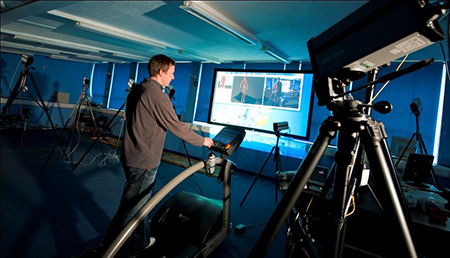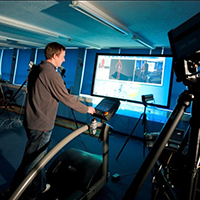The study analysed 25,000 human steps made on a pressure-sensitive treadmill at the University’s Gait Laboratory
Research at the University of Liverpool has shown that the mechanisms of the human foot are not as unique as originally thought and have much more in common with the flexible feet of other great apes.
Current understanding of the evolution of human walking is based on research from the 1930s, which proposes that human feet function very differently to those of other apes, due to the development of arches in the mid-foot region and the supposed rigidity of that on the outside edge of the foot.
Surprising amount of flexibility
In a study of more than 25,000 human steps made on a pressure-sensitive treadmill at the University’s Gait Laboratory, scientists at Liverpool have shown that despite having abandoned life in the trees long ago, our feet have retained a surprising amount of flexibility, the type seen in the feet of other great apes, such as orang-utans and chimpanzees, that have remained largely tree-dwelling.
“This supposed ‘uniqueness’, however, has never been quantitatively tested. We found that the range of pressures exerted under the human mid-foot, and thus the internal mechanisms that drive them, were highly variable, so much so that they actually overlapped with those made by the great apes.”
Dr Karl Bates, from the University’s Institute of Ageing and Chronic Disease, said: “Our ancestors probably first developed flexibility in their feet when they were primarily tree-dwelling, and moving on bendy branches, but as time passed and we became more and more ground-dwelling animals, some new features evolved to enable us to move quickly on the ground.
Continuum of variation
“Our limbs, however, did not adapt to life on the ground anywhere near as much as those of other ground-dwelling animals such as horses, hares and dogs. Our tests showed that our feet are not as stiff as originally thought and actually form part of a continuum of variation with those of other great apes.
“We hypothesise that despite becoming nearly exclusively ground dwelling we have retained flexibility in the feet to allow us to cope effectively with the differences in hard and soft ground surfaces which we encounter in long distance walking and running. The next part of our study will be testing this theory, which could offer a reason why humans can outrun a horse, for example, over long distances on irregular terrain.”
The research, published in the journal, Proceedings of the Royal Society B, is supported by the Natural Environment Research Council (NERC); The Leverhulme Trust; and the Royal Society, and forms part of research by the University’s Centre for Integrated Research into Musculoskeletal Ageing, funded by the Medical Research Council and Arthritis Research UK.

